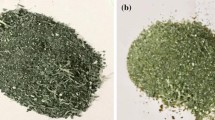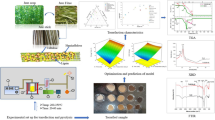Abstract
In this paper, bio-oil production, kinetics analysis, and exergy analysis of Prosopis juliflora pyrolysis are reported. The biomass was segregated into two different particle sizes (< 0.5 mm and > 2.0 mm). Elemental analysis and higher heating value of Prosopis juliflora biomass were estimated. Thermogravimetric analysis of biomass was performed at 5 different heating rates of (5 °C min−1, 10 °C min−1, 15 °C min−1, 20 °C min−1, 25 °C min−1). Thermal degradation of Prosopis juliflora biomass was performed at different temperature ranging from 400 °C, 450 °C, 500 °C, 550 °C to 600 °C. The maximum liquid yield was 17.4% obtained at 500 °C with 0.5 mm particle size. Gas chromatography-mass spectrometry analysis of the Prosopis juliflora liquid phase showed the presence of petroleum compounds. Iso-conversion method is used to establish the kinetic parameters. The mean activation energies obtained from the Kissinger, Kissinger-Akahira-Sunose, Ozawa-Flynn-Wall, and Friedman model are 107.583 kJ mol−1, 138.78 kJ mol−1,145.36 kJ mol−1, and 157.21 kJ mol−1 respectively. The maximum exergy efficiency for pyro-gas was 54.92%, with a particle size of < 0.5 mm at 600 °C. The present study shows that hazardous material like Prosopis juliflora can be converted into energy-dense fuel, thereby paving way for mitigation of the toxic weed.

Graphical abstract






Similar content being viewed by others
Abbreviations
- A :
-
Pre-exponential factor, min−1
- En:
-
Energy of 1 kg biomass, kJ
- Ex:
-
Exergy of 1 kg biomass, kJ
- E a :
-
Activation energy, J mol−1
- R :
-
Gas constant, J mol K−1
- C p :
-
Constant pressure-specific heat capacity
- T :
-
Temperature, °C
- P :
-
Pressure, Pa
- H :
-
Specific enthalpy, kJ kmol−1
- S :
-
Specific entropy, kJ kmol−1
- X i :
-
Mole fraction of ith species
- ex:
-
Standard specific exergy, kJ kmol−1
- β :
-
Heating rate
- Ƞ:
-
Energy efficiency or percentage
- Ψ:
-
Exergy efficiency or percentage
- α:
-
Conversion rate
- Ki:
-
Kinetic energy
- Po:
-
Potential energy
- Ph:
-
Physical energy
- Ch:
-
Chemical energy
- O:
-
Ambient condition
- I:
-
Initial biomass
- F:
-
Final biomass
- Heat:
-
Related to heat
- t:
-
Biomass sample at time
- T:
-
Related to temperature
- Gas:
-
Related to gas
- Biomass:
-
Related to biomass
- LHV:
-
Low heating value, kJ kg−1
- HHV:
-
High heating value, kJ kg−1
- PJ:
-
Prosopis juliflora
- KM:
-
Kissinger model
- KASM:
-
Kissinger-Akahira-Sunose model
- OFWM:
-
Ozawa-Flynn-Wall model
- FM:
-
Friedman model
References
Ramli T, Ali A, Sri Rachmania J, Susianto (2019) Production of liquid fuel from plastic waste using integrated pyrolysis method with refinery distillation bubble cap plate column. Energy Rep 5:70–77. https://doi.org/10.1016/j.egyr.2018.11.004
Zubrik A, Matik M, Hredzák S, Lovás M, Danková Z, Kováčová M, Briančin J (2016) Preparation of chemically activated carbon from waste biomass by single-stage and two-stage pyrolysis. J Clean Prod 143:643–653. https://doi.org/10.1016/j.jclepro.2016.12.061
Lin X, Zhang Z, Sun J, Wang Q, Pittman C, P.. (2018) Catalytic fast pyrolysis of a wood-plastic composite with metal oxides as catalysts. Waste Manag 79:38–47. https://doi.org/10.1016/j.wasman.2018.07.021
Hernando H, Moreno I, Fermoso J, Hernandez C, Pizarro P, Coronado J, Cejika J, Serrano D (2017) Biomass catalytic fast pyrolysis over hierarchical ZSM-5 and Beta zeolites modified with Mg and Zn oxides. Biomass Convers Biorefin 7:289–304. https://doi.org/10.1007/s13399-017-0266-6
Wang H, Xia Q, Liu H (2019a) Quick estimation of f(E) in the distributed activation energy model (DAEM): an inverse problem approach. J Math Chem 57:1949–1972. https://doi.org/10.1007/s10910-019-01044-x
Wang S, Yuan C, Esakkimuthu S, Xu L, Cao B, Abomohra A, Qian L, Liu L, Hu Y (2019b) Catalytic pyrolysis of waste clay oil to produce high-quality biofuel. J Anal Appl Pyrolysis 141:104633. https://doi.org/10.1016/j.jaap.2019.104633
Drobíková K, Vallová S, Motyka O, Kutláková KM, Plachá D, Seidlerová J (2018) Effects of binder choice in converter and blast furnace sludge briquette preparation: environmental and practical implications. Waste Manag 79:30–37. https://doi.org/10.1016/j.wasman.2018.06.051
Lam SS, Mahari WAW, Jusoh A, Chong CT, Lee CL, Chased HA (2017) Pyrolysis using microwave absorbents as reaction bed: an improved approach to transform used frying oil into biofuel product with desirable properties. J Clean Prod 147:263–272. https://doi.org/10.1016/j.jclepro.2017.01.085
Kalargaris I, Tian G, Gu S (2017) The utilisation of oils produced from plastic waste at different pyrolysis temperatures in a DI diesel engine. Energy. 131:179–185. https://doi.org/10.1016/j.energy.2017.05.024
Zhang B, Zhong Z, Zhang J, Ruan R (2018) Catalytic fast co-pyrolysis of biomass and fusel alcohol to enhance aromatic hydrocarbon production over ZSM-5 catalyst in a fluidized bed reactor. J Anal Appl Pyrolysis 133:147–153. https://doi.org/10.1016/j.jaap.2018.04.009
Lim CH, Yakub Mohammed I, Abdalla Abakr Y, Kabir Kazi F, Yusup S, Loong LH (2016) Novel input-output prediction approach for biomass pyrolysis. J Clean Prod 136:51–61. https://doi.org/10.1016/j.jclepro.2016.04.141
Blanco A, Chejne F (2016) Modeling and simulation of biomass fast pyrolysis in a fluidized bed reactor. J Anal Appl Pyrolysis 318:105–114. https://doi.org/10.1016/j.jaap.2016.01.003
Antoniou N, Zabaniotou A (2015) Experimental proof of concept for a sustainable End of Life Tyres pyrolysis with energy and porous materials production. J Clean Prod 101:323–326. https://doi.org/10.1016/j.jclepro.2015.03.101
Wang H, Liu H (2019) Distribution-free estimation of f(E) in the distributed activation energy model based on matrix singular value decomposition method. Chem Pap 73:1893–1902. https://doi.org/10.1007/s11696-019-00742-9
Gonzalez-Quiroga A, Van Geem KM, Marin GB (2017) Towards first-principles based kinetic modeling of biomass fast pyrolysis. Biomass Conv Bioref 7:305–317. https://doi.org/10.1007/s13399-017-0251-0
Rincon F, Muñoz J, Ramírez P, Galan H, Carmen Alfaro M (2014) Physicochemical and rheological characterization of Prosopis juliflora seed gum aqueous dispersions. Food Hydrocoll 35:348–357. https://doi.org/10.1016/j.foodhyd.2013.06.013
García SG, Gullón B, Rivas S, Feijoo G, Teresa Moreira M (2016) Environmental performance of biomass refining into high-added value compounds. J Clean Prod 120:170–180. https://doi.org/10.1016/j.jclepro.2016.02.015
Shirke PA, Pathre UV (2004) Influence of leaf-to-air vapour pressure deficit (VPD) on the biochemistry and physiology of photosynthesis in Prosopis juliflora. J Exp Bot 55:2111–2120. https://doi.org/10.1093/jxb/erh229
Midhun Prasad K, Murugavelh S (2019) Co-pyrolysis of juliflora biomass with low density polyethylene for bio-oil synthesis. Energy Sources:1–16. https://doi.org/10.1080/15567036.2019.1635232
Pravin Kumar, S.A., Nagarajan, R., Midhun Prasad, K., Anand, B., Murugavelh, S., 2019. Thermogravimetric study and kinetics of banana peel pyrolysis: a comparison of ‘model-free’ methods. Biofuels 0, 1–10. https://doi.org/10.1080/17597269.2019.1647375
Johansson A, Sandström L, Öhrman O, Jilvero H (2018) Co-pyrolysis of woody biomass and plastic waste in both analytical and pilot scale. J Anal Appl Pyrolysis 134:102–113. https://doi.org/10.1016/j.jaap.2018.05.015
Kothari K, Shah AB, Murugavelh S (2015) Bio-oil production: pyrolysis of saw dust in an auger reactor. Int J ChemTech Res 8:349–357. https://doi.org/10.1515/ijcre-2016-0133
Mishra, R,K., Mohanty, K., 2018. Pyrolysis kinetics and thermal behaviour of waste sawdust biomass using thermogravimetric analysis. Bioresour Technol 251, 63-74. doi: https://doi.org/10.1016/j.biortech.2017.12.029.
Sophonrat N, Sandström L, Johansson AC, Yang W (2017) Co-pyrolysis of mixed plastics and cellulose: an interaction study by Py-GC×GC/MS. Energy Fuel 31:11078–11090. https://doi.org/10.1021/acs.energyfuels.7b01887
Wang SR, Dai GX, Yang HP, Luo ZY (2017) Lignocellulosic biomass pyrolysis mechanism: a state-of-the-art review. Prog Energy Combust Sci 62:33–86. https://doi.org/10.1016/j.pecs.2017.05.004
Parvez AM, Mujtaba IM, Tao WU (2016) Energy exergy and environmental analyses of conventional, steam and CO2- enhanced rice straw gasification. Energy. 94:579–588. https://doi.org/10.1016/j.energy.2015.11.022
Gómez N, Rosas JG, Cara J, Martínez O, Alburquerque JA, Sánchez ME (2016) Slow pyrolysis of relevant biomasses in the Mediterranean basin. Part 1. Effect of temperature on process performance on a pilot scale. J Clean Prod 120:181–190. https://doi.org/10.1016/j.jclepro.2014.10.082
Funding
This research work was finically supported by (SERB) Science and Engineering Research Board, Science and Engineering Research, under the ECR scheme (ECR/2016/001304).
Author information
Authors and Affiliations
Corresponding author
Additional information
Publisher’s Note
Springer Nature remains neutral with regard to jurisdictional claims in published maps and institutional affiliations.
Rights and permissions
About this article
Cite this article
Ramesh, N., Murugavelh, S. A cleaner process for conversion of invasive weed (Prosopis juliflora) into energy-dense fuel: kinetics, energy, and exergy analysis of pyrolysis process. Biomass Conv. Bioref. 12, 3067–3080 (2022). https://doi.org/10.1007/s13399-020-00747-5
Received:
Revised:
Accepted:
Published:
Issue Date:
DOI: https://doi.org/10.1007/s13399-020-00747-5




